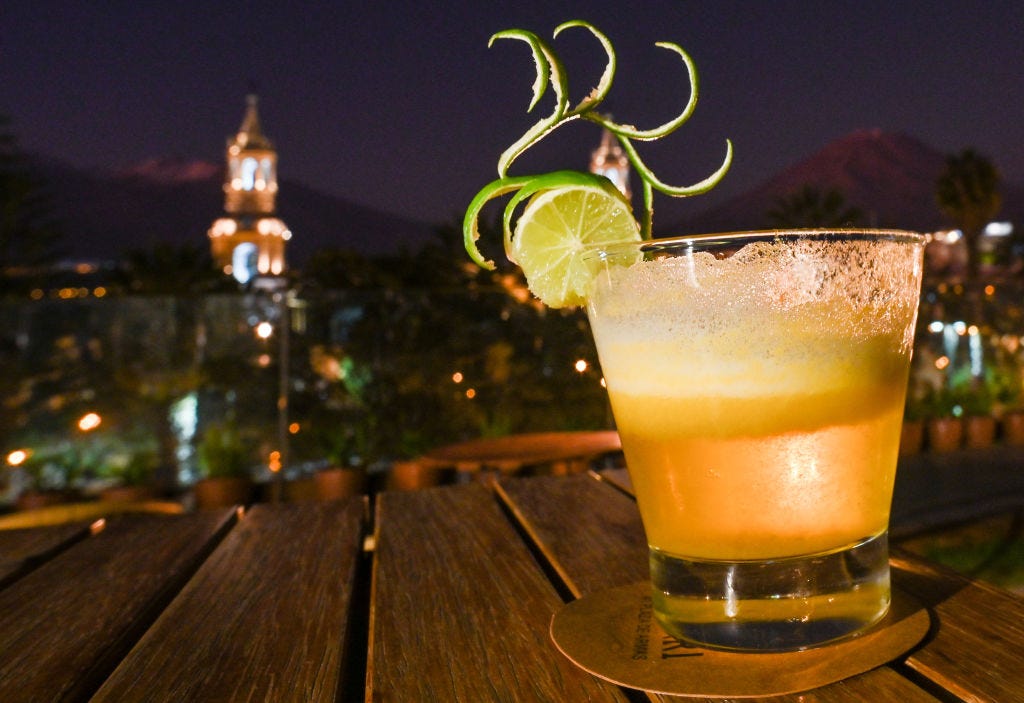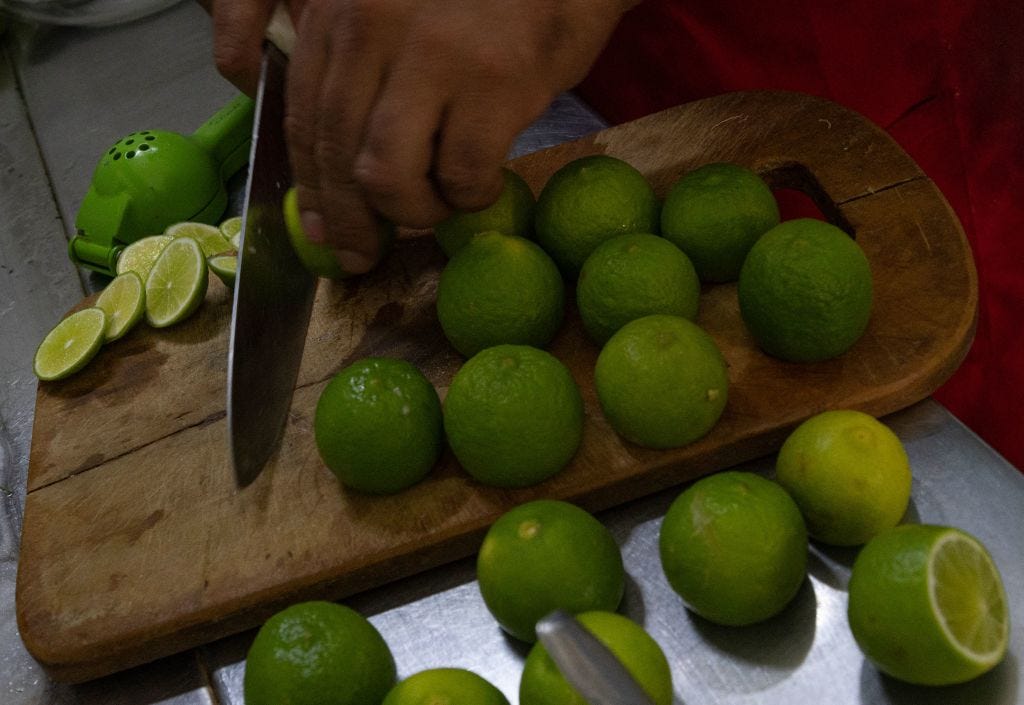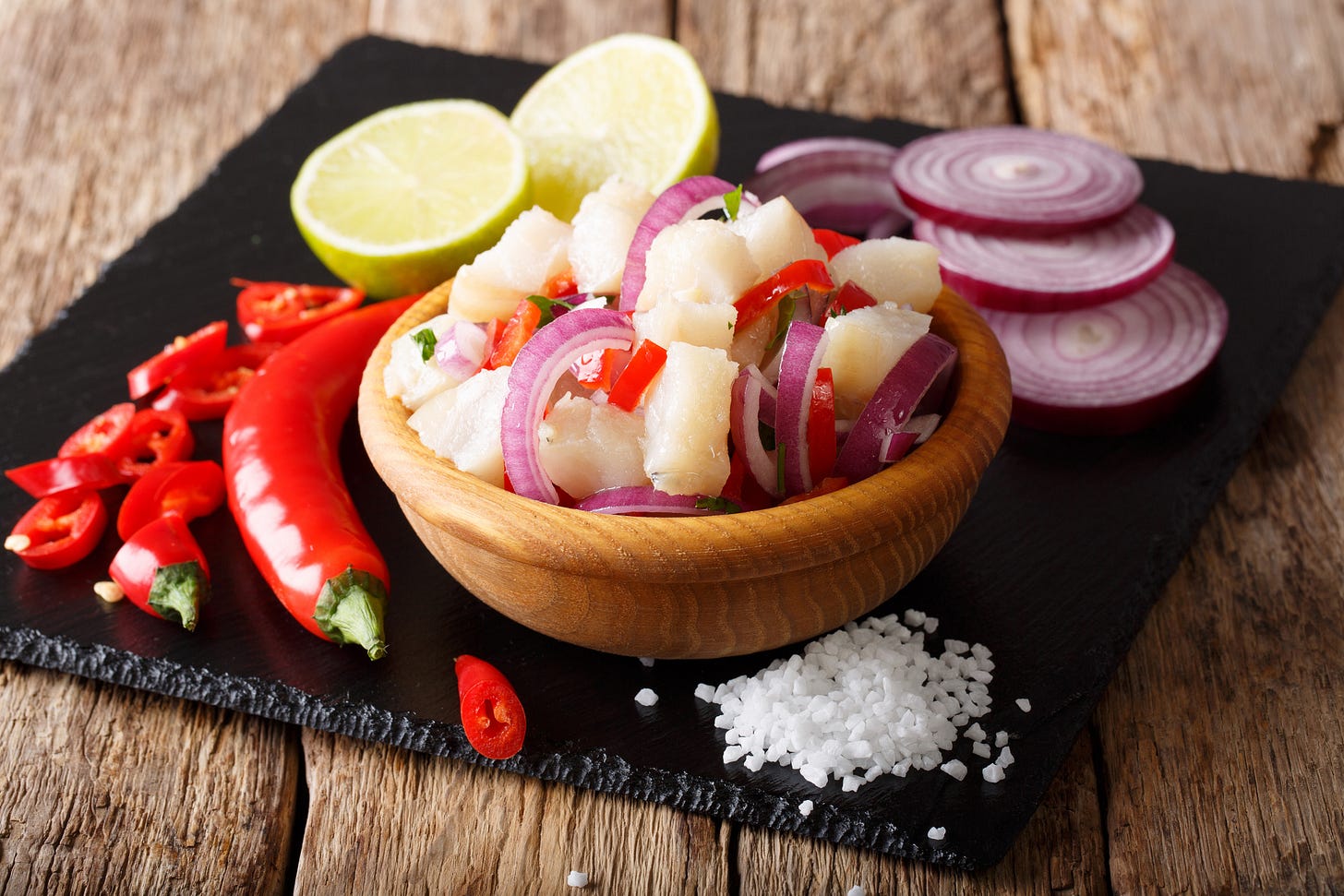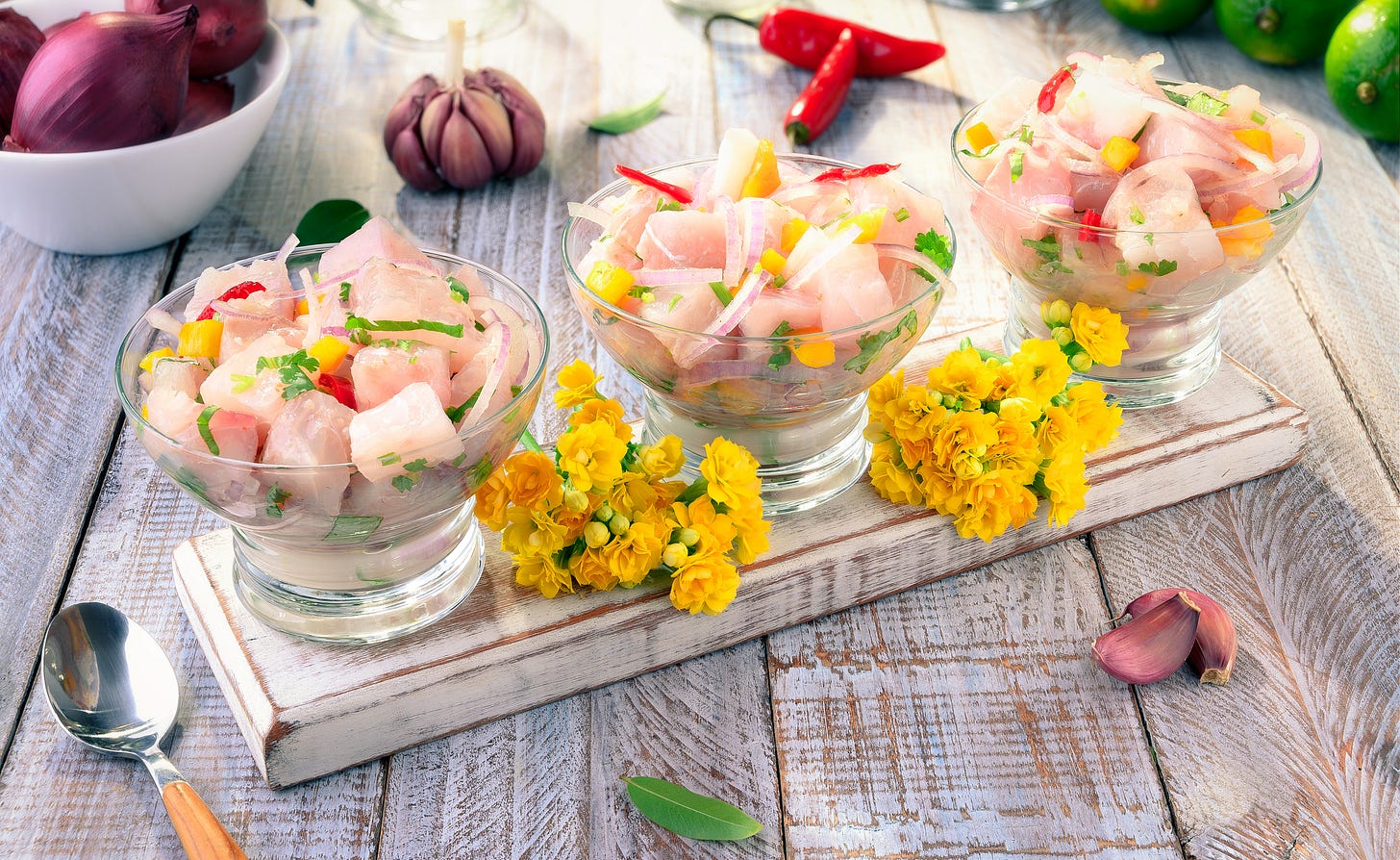The Lime Crisis in Peru
Why climate change and unsustainable agriculture is threatening our iconic creations
Who amongst us have had the good fortune to taste Peruvian ceviche and not come away with the realisation that raw fish and lime juice are destined to be together?
Well, I’m one of the converts and - purists, please don’t hate me - despite not having yet set foot in Peru, I rarely hesitate to order a ceviche whenever it is on any menu in front of me.
So when I saw Jose Luis’ post on LinkedIn a few weeks ago talking about the lime shortage in his home country, I had to get in touch and ask him to write an expanded version for Thin Ink. He has very graciously done so and the timing is perfect, because I am in the midst of 15-hour-a-day work week to meet deadlines.
So no Thin’s Pickings this week, but hopefully I can share the fruits of that labour next week if/when the stories are published. Wish me luck.
José Luis Chicoma
José Luis Chicoma served as Minister of Production in Peru. Currently, he advises international organizations on global food systems, including UNDP.
The lime crisis permeated every aspect of Peruvian media: from primetime television to news and radio shows. The scarcity and soaring prices of limes in Peru, which surged from just over one to nearly 16 US dollars per kilo in August and September of this year, garnered more media coverage than major political and international events.
The burning question that caused distress and anxiety among the population, echoed in every media interview with experts and authorities, was: when will limes return to their normal prices? Yet, nobody could provide a definite answer.
Peru is obsessed with its lime. It's a key ingredient in two of its iconic creations: ceviche and pisco sour.
Yes, I know there are variations of ceviche in many countries, and any culture with coastlines and lakes has its own version of raw fish marinated in citrus. However, I strongly advise against debating the origin of ceviche with a Peruvian. I fear for your physical (and mental) well-being.
We are immensely proud of what we believe is the best ceviche on the planet. The lime we use is crucial to provide the high acidity which is the essence of a good ceviche or the famous "leche de tigre”. In its simplest form, this is just lime juice mixed with salt, ajíes (chili peppers) and onions used to bath fresh fish for a few seconds or minutes before serving.
Pisco sour is a cocktail crafted with pisco - the Peruvian brandy - syrup, egg white, and that uniquely special lime which harmonises effortlessly with the grape spirit.
Let me clarify, I'm not asserting that the Peruvian lime reigns supreme globally. In fact, the Spaniards brought limes to South America from Southeast Asia in the sixteenth century, and these green fruits found fertile ground in various regions.
Here in Mexico, where I'm writing this article, I adore the limes from Michoacan and Veracruz for my tacos and margaritas; they seem like a match made in heaven. However, I find it very hard to use them to craft a perfect ceviche or pisco sour - although, that might be because of my culinary and mixology skills or lack thereof, despite having plenty of enthusiasm.
Now you understand the importance of this lime in Peruvian culinary culture.
So, when the usually low-profile Minister of Economy suggested that it was best to eat a stir-fried chicken for a while, he became yet another unpopular figure in a government already facing widespread public disapproval.
The Minister of Agriculture had an even worse fate; she was removed from office after proposing the use of vinegar or cider instead of lime, sparking outrage in a society that does not tolerate anyone tampering with its national symbols.

The truth is that limes and Peruvian agriculture have fallen victim to a perfect storm, blending climate change and environmental shocks, distant wars, and a conspicuous government incapacity to bolster food systems resilience.
Thanks to El Niño (an increasingly recurring climate shock), Cyclone Yaku and other unusual temperature and rainfall fluctuations, the lime blossom was significantly delayed and threatened. These climatic variations, in general, have given rise to one of the most disastrous agricultural seasons in Peru in recent decades, also affecting potato and maize harvests, livestock, and other export products such as coffee and cocoa, which are under attack from pests and diseases.
Moreover, as is the case in many other regions of the world, agriculture - not only industrial but also small-scale farming - has increased its dependence on chemical fertilisers, herbicides, and pesticides in recent decades. The Russian invasion in Ukraine exposed the addiction of many crops to these chemicals, and the impact is felt even more strongly now, more than a year after that terrible war began.
Many crops have experienced severe withdrawal symptoms, hindering their ability to maintain the same level of productivity as before. Peru relies primarily on imports of chemical fertilisers from Russia, which became less available and significantly more expensive following the invasion of Ukraine.
Like other crops, the reduced application of these fertilisers on limes has affected their production, especially for small-scale farmers who couldn't obtain or afford the high prices of these chemicals.
To make matters worse, the Peruvian government has been highly ineffective in providing decisive support to its farmers, particularly those, like the lime growers, who are responsible for feeding the population. It would be easy to lay the blame solely on the current government but the problem is both structural and historical.
Export-oriented industrial agriculture has received significant attention from politicians and public officials.
Since the structural adjustment reforms of the 1990s, there has been a focus on public investments, free trade agreements to open new markets, tax incentives and institutional support in the public sector for the agro-export sector. This has led to a boom that has positioned Peru as one of the leading exporters of blueberries, asparagus, avocados, and others.
However, on the other side of the coin, small-scale agriculture (and fishing) — precisely the sector that sustains the population — has been overlooked. For decades, technocrats focused on the industrial and larger scale sectors and deemed small-scale as obsolete and lacking a future.
Smallholder farmers provide almost 60% of the food consumed by the population, and in a country where half of the people face food insecurity, their critical role in nourishing the Peruvian people has been neglected. Public policies fail to recognise the vital contribution of small-scale producers in preserving and harnessing biodiversity in a mega-diverse nation boasting two major centers of origin and diversity — the Andes and the Amazon — as well as one of the planet's most productive oceans.
In a cruel paradox reminiscent of many other developing countries, those producing food for the population are the ones plagued by the most profound food insecurity and poverty.
These long-standing issues don't absolve the current inept government of its responsibility. Faced with immense instability and a political crisis largely of their own making, they have failed to respond effectively, neglecting to support these small-scale producers.

In one of my favourite restaurants in Lima, La Picantería, the chef and owner Héctor Solís takes pride in using one of Peru's best limes for his exquisite ceviches, sourced from a city in the north of the country called Olmos. These limes strike a perfect balance between acidity, aroma, and flavour.
A few years ago, I visited Olmos—incidentally, my father's birthplace—and had the opportunity to talk with many farmers who were immensely proud of the quality of their citrus fruits and the growth in their lime production, driven by increasing demand from restaurants and cevicherías.
However, a few weeks ago, I read with great sadness how lime production in Olmos – because of those climate shocks, difficult access to fertilisers and lack of government support - plummeted from 400 tons to just 1 ton per week, significantly affecting the livelihoods of these farmers.
The real long-term solutions are crystal clear, not just for limes, Olmos and Peru, but for many developing countries facing similar challenges. It involves accepting that climate change is a reality, and one of its most evident victims is small-scale agriculture, and consequently, the plates of everyone, particularly those most vulnerable.
It means investing more resources in programs supporting climate adaptation and capacity building in small-scale agriculture and fishing, which should be the top priority in the agricultural and fishing sectors.
It entails promoting a swift transition towards agroecology and other sustainable farming models, reducing harmful chemical dependency in the fields and vulnerability to international price fluctuations of these inputs.
Moreover, it demands the formulation of systemic solutions, which, though sounding abstract, translates practically into governments developing visions that transcend mere economic growth.
Economic growth, left to its own devices, won't sustain itself in the long run. Instead, real sustainability lies in investing significantly in nutrition, social inclusion, and ecosystems. It's something we, even in places like Peru, with its natural abundance, tend to overlook, despite its potential to provide food, joy and pride to its people.
As always, please feel free to share this post and send tips and thoughts on mastodon @ThinInk@journa.host, my LinkedIn page, twitter @thinink, or via e-mail thin@thin-ink.net.






